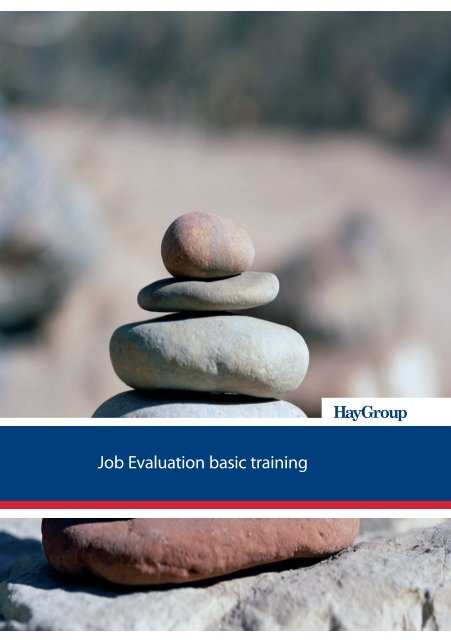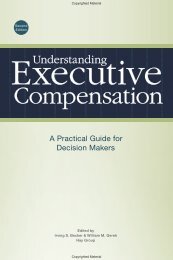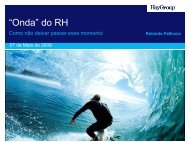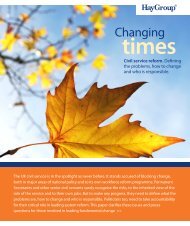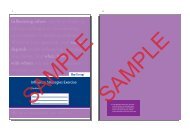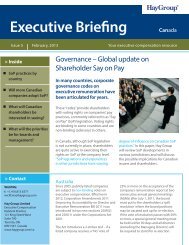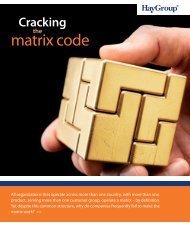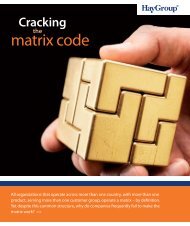Job Evaluation basic training - Hay Group
Job Evaluation basic training - Hay Group
Job Evaluation basic training - Hay Group
You also want an ePaper? Increase the reach of your titles
YUMPU automatically turns print PDFs into web optimized ePapers that Google loves.
<strong>Job</strong> <strong>Evaluation</strong> <strong>basic</strong> <strong>training</strong>
It’s the most widely used method in the world.<br />
Would you like to know why?<br />
When it comes to <strong>Job</strong> <strong>Evaluation</strong>, <strong>Hay</strong> <strong>Group</strong> pretty much wrote the book. Since<br />
the 1950’s when Ned <strong>Hay</strong> and Dale Purves built on the work of the early JE<br />
pioneers and developed a ‘definitive’ method for measuring work, the <strong>Hay</strong> Guide<br />
Chart®- Profile Method of <strong>Job</strong> <strong>Evaluation</strong> has become the most widely used in<br />
the world.<br />
Our knowledge and experience in the field is vast and over the last five decades<br />
<strong>Hay</strong> <strong>Group</strong> has used the method in assisting thousands of organisations through<br />
periods of growth, improvement and change.<br />
This programme is only open to organisations that already use the <strong>Hay</strong> Guide<br />
Chart®- Profile Method. It is designed for individuals who are accountable for<br />
describing, analysing, designing and measuring work in their organisations. This<br />
includes professionals in compensation and benefits, organisation effectiveness<br />
and human resources development as well as line managers asked to participate<br />
in these processes. As the course is designed to teach the <strong>basic</strong>s of how to<br />
evaluate using the <strong>Hay</strong> Guide Charts®, it is intended for individuals who need<br />
to evaluate jobs and roles, yet have little or no previous experience with <strong>Hay</strong><br />
<strong>Group</strong>’s methodology.<br />
‘‘<br />
the most<br />
widely used method<br />
in the world<br />
’’<br />
The <strong>Hay</strong> Guide Chart®-Profile Method of <strong>Job</strong> <strong>Evaluation</strong> is the most<br />
widely used in the world and can be used in a variety of organisation<br />
and human resource applications – not just for compensation<br />
and benefit purposes!
So, what does this mean for you and your<br />
organisation?<br />
It might be a merger or acquisition, new structure design, changing roles, or<br />
simply a grade structure that doesn’t fit the needs of the organisation any more.<br />
Maybe you need the rigour of an analytical job evaluation method to support an<br />
equal pay review.<br />
Regardless of the reason, organisations need a sound and straightforward<br />
method to measure and value work on an on-going basis – one that reflects<br />
their specific culture and values effectively. It doesn’t matter what sector<br />
you work in, todays organisations benefit from using well thought through<br />
approaches when describing, analysing and evaluating work – for reward<br />
purposes as well as a variety of related organisation and human resources<br />
applications.<br />
Your organisation already understands these benefits, but perhaps you are<br />
new to the organisation or new to the world of organisation design, grading or<br />
reward. If you want, or need, to learn the <strong>basic</strong>s of how to evaluate jobs then this<br />
course is a must.<br />
We’ve made a world of difference to how<br />
thousands of organisations design and value<br />
work<br />
The <strong>Hay</strong> <strong>Group</strong> method enables you to define and compare jobs within, and<br />
across, business units with unsurpassed rigour. The unique integrated model<br />
enables evaluation across an entire organisation or within distinct job groups or<br />
families. Since the development of the Guide Charts® in the mid-to-late 50s the<br />
method has been updated and developed to suit different sectors and cultures<br />
and is now used in more than 90 countries. It has been applied in both public<br />
and private organisations to evaluate millions of jobs at all levels across the<br />
world.
Learn the <strong>basic</strong>s from the expert<br />
This two day course will give you a <strong>basic</strong> understanding of how to<br />
calculate jobs and roles using the <strong>Hay</strong> <strong>Group</strong> method. Our experts will<br />
teach you in an interactive way using a case study and in group exercises.<br />
You’ll learn just why job evaluation is so important, how to evaluate<br />
work, and techniques for ensuring consistency and reliability. As well as<br />
this hands on practise, you’ll have the benefit of discussing the issues<br />
with a senior <strong>Hay</strong> <strong>Group</strong> consultant and share experiences with other<br />
<strong>Hay</strong> <strong>Group</strong> clients.<br />
With your new skills you will be able to:<br />
<br />
<br />
<br />
<br />
understand the basis of the <strong>Hay</strong> <strong>Group</strong> method and the process by<br />
which it is applied<br />
have hands on experience of evaluating different job types in the<br />
context of an organisational structure<br />
develop insights into the concepts underlying the <strong>Hay</strong> <strong>Group</strong><br />
method and its role in supporting reward systems<br />
be prepared to challenge the process for valuing work and how best<br />
to design jobs or roles<br />
Demand for these workshops is high. Contact us as soon as possible to<br />
reserve your place.<br />
This programme is only open to organisations that already use the <strong>Hay</strong><br />
Guide Chart®- Profile Method<br />
<strong>Hay</strong> <strong>Group</strong><br />
Tel: +47 24 12 40 60<br />
web: www.haygroup.com<br />
email: margrete.henriksen@haygroup.com


